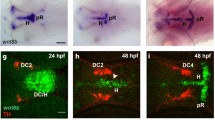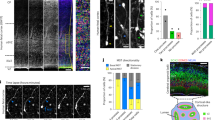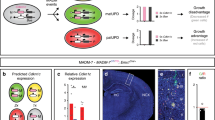Abstract
The ability of the mature mammalian nervous system to continually produce neuronal precursors is of considerable importance, as manipulation of this process might one day permit the replacement of cells lost as a result of injury or disease. In mammals, the anterior subventricular zone (SVZa) region is one of the primary sites of adult neurogenesis. Here we show that doublecortin (DCX), a widely used marker for newly generated neurons, when deleted in mice results in a severe morphological defect in the rostral migratory stream and delayed neuronal migration that is independent of direction or responsiveness to Slit chemorepulsion. DCX is required for nuclear translocation and maintenance of bipolar morphology during migration of these cells. Our data identifies a critical function for DCX in the movement of newly generated neurons in the adult brain.
This is a preview of subscription content, access via your institution
Access options
Subscribe to this journal
Receive 12 print issues and online access
$209.00 per year
only $17.42 per issue
Buy this article
- Purchase on Springer Link
- Instant access to full article PDF
Prices may be subject to local taxes which are calculated during checkout





Similar content being viewed by others
References
Abrous, D.N., Koehl, M. & Le Moal, M. Adult neurogenesis: from precursors to network and physiology. Physiol. Rev. 85, 523–569 (2005).
Lois, C., Garcia-Verdugo, J.M. & Alvarez-Buylla, A. Chain migration of neuronal precursors. Science 271, 978–981 (1996).
Doetsch, F., Caille, I., Lim, D.A., Garcia-Verdugo, J.M. & Alvarez-Buylla, A. Subventricular zone astrocytes are neural stem cells in the adult mammalian brain. Cell 97, 703–716 (1999).
Garcia, A.D., Doan, N.B., Imura, T., Bush, T.G. & Sofroniew, M.V. GFAP-expressing progenitors are the principal source of constitutive neurogenesis in adult mouse forebrain. Nat. Neurosci. 7, 1233–1241 (2004).
Doetsch, F. & Alvarez-Buylla, A. Network of tangential pathways for neuronal migration in adult mammalian brain. Proc. Natl. Acad. Sci. USA 93, 14895–14900 (1996).
Nguyen-Ba-Charvet, K.T. et al. Multiple roles for slits in the control of cell migration in the rostral migratory stream. J. Neurosci. 24, 1497–1506 (2004).
Wu, W. et al. Directional guidance of neuronal migration in the olfactory system by the protein Slit. Nature 400, 331–336 (1999).
Hack, I., Bancila, M., Loulier, K., Carroll, P. & Cremer, H. Reelin is a detachment signal in tangential chain-migration during postnatal neurogenesis. Nat. Neurosci. 5, 939–945 (2002).
Hu, H. Chemorepulsion of neuronal migration by Slit2 in the developing mammalian forebrain. Neuron 23, 703–711 (1999).
Anton, E.S. et al. Receptor tyrosine kinase ErbB4 modulates neuroblast migration and placement in the adult forebrain. Nat. Neurosci. 7, 1319–1328 (2004).
Murase, S. & Horwitz, A.F. Deleted in colorectal carcinoma and differentially expressed integrins mediate the directional migration of neural precursors in the rostral migratory stream. J. Neurosci. 22, 3568–3579 (2002).
Chazal, G., Durbec, P., Jankovski, A., Rougon, G. & Cremer, H. Consequences of neural cell adhesion molecule deficiency on cell migration in the rostral migratory stream of the mouse. J. Neurosci. 20, 1446–1457 (2000).
Hu, H., Tomasiewicz, H., Magnuson, T. & Rutishauser, U. The role of polysialic acid in migration of olfactory bulb interneuron precursors in the subventricular zone. Neuron 16, 735–743 (1996).
Petreanu, L. & Alvarez-Buylla, A. Maturation and death of adult-born olfactory bulb granule neurons: role of olfaction. J. Neurosci. 22, 6106–6113 (2002).
Winner, B., Cooper-Kuhn, C.M., Aigner, R., Winkler, J. & Kuhn, H.G. Long-term survival and cell death of newly generated neurons in the adult rat olfactory bulb. Eur. J. Neurosci. 16, 1681–1689 (2002).
des Portes, V. et al. doublecortin is the major gene causing X-linked subcortical laminar heterotopia (SCLH). Hum Mol Genet 7, 1063–70 (1998).
Corbo, J.C. et al. Doublecortin Is required in mice for lamination of the hippocampus but not the neocortex. J. Neurosci. 22, 7548–7557 (2002).
Nacher, J., Crespo, C. & McEwen, B.S. Doublecortin expression in the adult rat telencephalon. Eur. J. Neurosci. 14, 629–644 (2001).
Brown, J.P. et al. Transient expression of doublecortin during adult neurogenesis. J. Comp. Neurol. 467, 1–10 (2003).
Kosaka, K. et al. Chemically defined neuron groups and their subpopulations in the glomerular layer of the rat main olfactory bulb. Neurosci. Res. 23, 73–88 (1995).
Brinon, J.G. et al. Calbindin D-28k-positive neurons in the rat olfactory bulb. An immunohistochemical study. Cell Tissue Res. 269, 289–297 (1992).
Gong, S. et al. A gene expression atlas of the central nervous system based on bacterial artificial chromosomes. Nature 425, 917–925 (2003).
Ward, M., McCann, C., DeWulf, M., Wu, J.Y. & Rao, Y. Distinguishing between directional guidance and motility regulation in neuronal migration. J. Neurosci. 23, 5170–5177 (2003).
Del Rio, J.A. et al. MAP1B is required for Netrin 1 signaling in neuronal migration and axonal guidance. Curr. Biol. 14, 840–850 (2004).
Tsai, L.H. & Gleeson, J.G. Nucleokinesis in neuronal migration. Neuron 46, 383–388 (2005).
Francis, F. et al. Doublecortin is a developmentally regulated, microtubule-associated protein expressed in migrating and differentiating neurons. Neuron 23, 247–256 (1999).
Friocourt, G. et al. Doublecortin functions at the extremities of growing neuronal processes. Cereb. Cortex 13, 620–626 (2003).
Tanaka, T. et al. Lis1 and doublecortin function with dynein to mediate coupling of the nucleus to the centrosome in neuronal migration. J. Cell Biol. 165, 709–721 (2004).
Shu, T. et al. Ndel1 operates in a common pathway with LIS1 and cytoplasmic dynein to regulate cortical neuronal positioning. Neuron 44, 263–277 (2004).
Solecki, D.J., Model, L., Gaetz, J., Kapoor, T.M. & Hatten, M.E. Par6alpha signaling controls glial-guided neuronal migration. Nat. Neurosci. 7, 1195–1203 (2004).
Higginbotham, H., Bielas, S., Tanaka, T. & Gleeson, J.G. Transgenic mouse line with green-fluorescent protein-labeled Centrin 2 allows visualization of the centrosome in living cells. Transgenic Res. 13, 155–164 (2004).
Bai, J. et al. RNAi reveals doublecortin is required for radial migration in rat neocortex. Nat. Neurosci. 6, 1277–1283 (2003).
Yoshihara, S., Omichi, K., Yanazawa, M., Kitamura, K. & Yoshihara, Y. Arx homeobox gene is essential for development of mouse olfactory system. Development 132, 751–762 (2005).
Rakic, P. Neuron-glia relationship during granule cell migration in developing cerebellar cortex. A Golgi and electronmicroscopic study in Macacus Rhesus. J. Comp. Neurol. 141, 283–312 (1971).
Gregory, W.A., Edmondson, J.C., Hatten, M.E. & Mason, C.A. Cytology and neuron-glial apposition of migrating cerebellar granule cells in vitro. J. Neurosci. 8, 1728–1738 (1988).
Rivas, R.J. & Hatten, M.E. Motility and cytoskeletal organization of migrating cerebellar granule neurons. J. Neurosci. 15, 981–989 (1995).
Gupta, A. et al. Layering defect in p35 deficiency is linked to improper neuronal-glial interaction in radial migration. Nat. Neurosci. 6, 1284–1291 (2003).
Tanaka, T. et al. Cdk5 phosphorylation of doublecortin ser297 regulates its effect on neuronal migration. Neuron 41, 215–227 (2004).
Ward, M.E., Jiang, H. & Rao, Y. Regulated formation and selection of neuronal processes underlie directional guidance of neuronal migration. Mol. Cell. Neurosci. 30, 378–387 (2005).
Deuel, T.A. et al. Genetic interactions between doublecortin and doublecortin-like kinase in neuronal migration and axon outgrowth. Neuron 49, 41–53 (2006).
Koizumi, H., Tanaka, T. & Gleeson, J.G. Doublecortin-like kinase functions with doublecortin to mediate fiber tract decussation and neuronal migration. Neuron 49, 55–66 (2006).
Hirotsune, S. et al. Graded reduction of Pafah1b1 (Lis1) activity results in neuronal migration defects and early embryonic lethality. Nat. Genet. 19, 333–339 (1998).
McManus, M.F., Nasrallah, I.M., Pancoast, M.M., Wynshaw-Boris, A. & Golden, J.A. Lis1 is necessary for normal non-radial migration of inhibitory interneurons. Am. J. Pathol. 165, 775–784 (2004).
Sanada, K., Gupta, A. & Tsai, L.H. Disabled-1-regulated adhesion of migrating neurons to radial glial fiber contributes to neuronal positioning during early corticogenesis. Neuron 42, 197–211 (2004).
Gleeson, J.G., Lin, P.T., Flanagan, L.A. & Walsh, C.A. Doublecortin is a microtubule-associated protein and is expressed widely by migrating neurons. Neuron 23, 257–271 (1999).
Liu, G. & Rao, Y. Neuronal migration from the forebrain to the olfactory bulb requires a new attractant persistent in the olfactory bulb. J. Neurosci. 23, 6651–6659 (2003).
Mimori-Kiyosue, Y., Shiina, N. & Tsukita, S. The dynamic behavior of the APC-binding protein EB1 on the distal ends of microtubules. Curr. Biol. 10, 865–868 (2000).
Rubinson, D.A. et al. A lentivirus-based system to functionally silence genes in primary mammalian cells, stem cells and transgenic mice by RNA interference. Nat. Genet. 33, 401–406 (2003).
Miyoshi, H., Blomer, U., Takahashi, M., Gage, F.H. & Verma, I.M. Development of a self-inactivating lentivirus vector. J. Virol. 72, 8150–8157 (1998).
Acknowledgements
The authors wish to thank A. Wynshaw-Boris (University of California, San Diego) and C. Walsh (Howard Hughes Medical Institute, Harvard Medical School, Boston) for Dcx knockout mice; M. Hatten and N. Heitz (Rockefeller University, New York; http://www.gensat.org; NIH NS02331), and J. Winkler and L. Aigner (University of Regensburg, Regensburg, Germany) for Dcx::EGFP mice; M. Ward and Y. Rao (Northwestern University, Chicago) for help with the SVZa explant culture system and for the Slit-producing stable HEK293T cell line; S. Tsukita (Japan Science and Technology Corporation, Kyoto, Japan) for the GFP-EB1 clone; N. Woods and R. Marr (Salk Institute, La Jolla, California) for lentiviral vectors and assistance; and J. Isaacson for electrophysiological measurements. This work was funded by the National Institute of Neurological Disorders and Stroke (R01 NS04387 and NS47101). We thank the Neurosciences Microscopy Shared Facility at the University of California, San Diego, for imaging support.
Author information
Authors and Affiliations
Contributions
H.K. conducted the in vivo experiments. H.K., H.H. and T.P. conducted the in vitro experiments. H.H. prepared the virus and conditioned media. T.T. and B.C.B. provided technical and imaging expertise. All contributed to data analysis and manuscript preparation.
Corresponding author
Ethics declarations
Competing interests
The authors declare no competing financial interests.
Supplementary information
Supplementary Fig. 1
DCX expression in RMS and RMS morphological defects in Dcx null mice (PDF 714 kb)
Supplementary Fig. 2
No significant difference in numbers of calretinin (CR), parvalbumin (PV) or tyrosine hydroxylase (TH)-positive cells in the glomerular layer of Dcx−/y mice. (PDF 762 kb)
Supplementary Fig. 3
No apparent defect in responsiveness of Dcx Dcx−/y neurons to Slit chemorepulsion. (PDF 520 kb)
Supplementary Fig. 4
No apparent defects in centrosome structure and microtubule polymerization dynamics in Dcx−/y (PDF 294 kb)
Supplementary Video 1
Time-lapse imaging of neuronal movement from Dcx+/y; Dcx::EGFP. (MOV 1291 kb)
Supplementary Video 2
Time-lapse imaging of neuronal movement from Dcx−/y; Dcx::EGFP. (MOV 1582 kb)
Supplementary Video 3
Time-lapse DIC and fluorescent imaging of Dcx+/y; m⃗actin::Cetn2-EGFP isolated neurons in gel matrix. (MOV 1063 kb)
Supplementary Video 4
Time-lapse DIC and fluorescent imaging of Dcx−/y; m⃗actin::Cetn2-EGFP isolated neurons in gel matrix. (MOV 1022 kb)
Rights and permissions
About this article
Cite this article
Koizumi, H., Higginbotham, H., Poon, T. et al. Doublecortin maintains bipolar shape and nuclear translocation during migration in the adult forebrain. Nat Neurosci 9, 779–786 (2006). https://doi.org/10.1038/nn1704
Received:
Accepted:
Published:
Issue Date:
DOI: https://doi.org/10.1038/nn1704
This article is cited by
-
Amygdala DCX and blood Cdk14 are implicated as cross-species indicators of individual differences in fear, extinction, and resilience to trauma exposure
Molecular Psychiatry (2022)
-
Emerging intersections between neuroscience and glioma biology
Nature Neuroscience (2019)
-
In Vivo Phenotyping of Familial Parkinson’s Disease with Human Induced Pluripotent Stem Cells: A Proof-of-Concept Study
Neurochemical Research (2019)
-
Effect of skilled reaching training and enriched environment on generation of oligodendrocytes in the adult sensorimotor cortex and corpus callosum
BMC Neuroscience (2017)
-
Two distinct populations of doublecortin-positive cells in the perilesional zone of cortical infarcts
BMC Neuroscience (2015)



